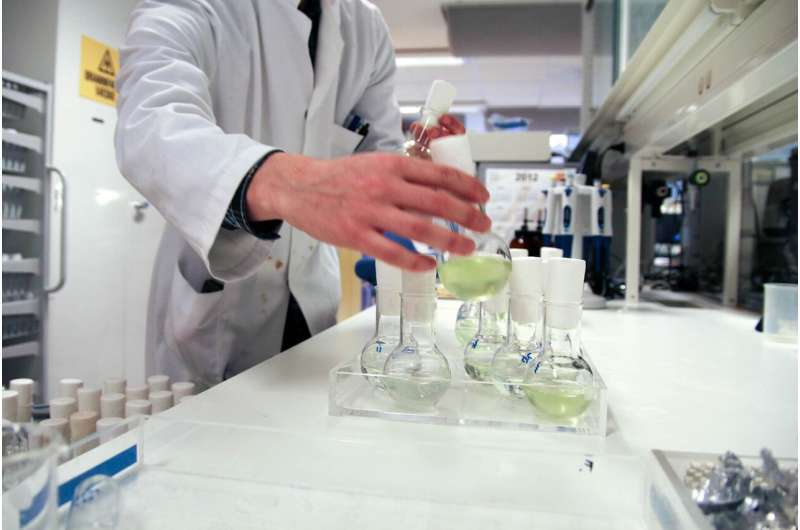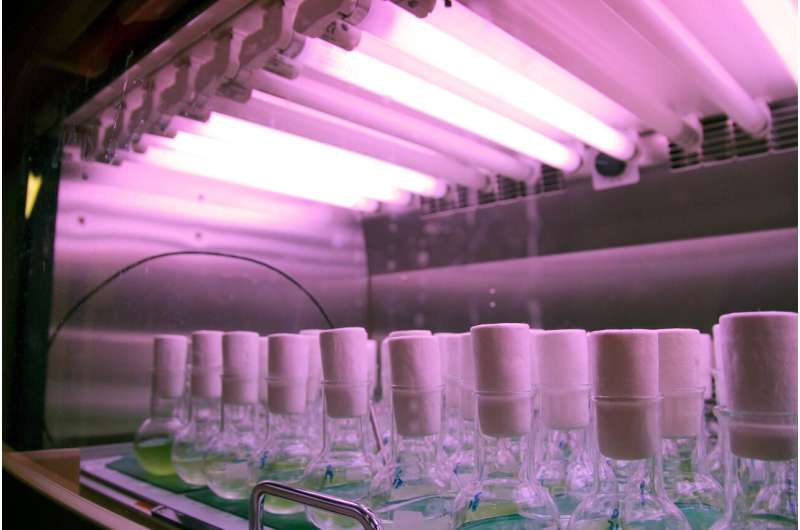For scientists, regulators, and conservationist, a more detailed measurement of individual algae cell health can provide early warning signs of possible hazardous contamination, thereby improving monitoring efforts significantly compared to the usual population-based parameters. Credit: Max Lotternes, NIVA
In today's world, where pollution and contamination frequently have a negative impact on our natural resources, it is vital to maintain regular and regulated testing of chemicals, toxins, or other forms of contamination. However, in order to do this properly, we need the correct tools and methods so that we can recognize when conditions aren't ideal.
Testing aquatic ecosystems
Freshwater ecosystems are particularly important to monitor, as they constitute the main drinking water resource for humans and other organisms, as well as being the home to a vast diversity of aquatic species. It is also important to regularly assess water quality to ensure that water bodies remain within expected environmental health standards.
There are many methods for testing water quality. For instance, investigating the health of microalgae—single-celled, photosynthesizing organisms, can tell us a lot about the presence of contaminants. Microalgae are at the base of the aquatic food chain, so changes in the abundance of this species or their reproductive rates, could have effects higher up in the food chain and possibly disturb the productivity of the entire ecosystem. Microalgal toxicity tests are required to analyze the toxicity of potentially hazardous substances in the aquatic environment, however these tests often do not illustrate how toxins physically impact microalgal cells.
Many microalgal species inhabit freshwater ecosystems, however the green microalgae Raphidocelis subcapitata is one of the most used in so-called bioassays (the assessment of the concentration or potency of a substance by its effects on living cells or tissues). Like most microalgae, R. subcapitata has a short generation time, meaning new cells are replicated rapidly, and is easy to culture in the laboratory. Currently, most toxicity bioassays of microalgae use growth and cell viability as indicators of toxicity in their environment. Although these parameters indicate how the microalgae population is doing and are ecologically relevant, they do not provide any information on how contaminants disturb specific biological processes in the algal cells. For scientists, regulators, and conservationist, a more detailed measurement of individual algae cell health can provide early warning signs of possible hazardous contamination, thereby improving monitoring efforts significantly compared to the usual population-based parameters.
Since the health of the environment is critical to the development of this microalgae, it is important to understand how different types of compounds cause a physiological response in cells, and which biological processes might be affected. In cooperation with the University of Osijek in Croatia, scientists from the Norwegian Institute of Water Research (NIVA) developed a model to identify the effects of compounds in different commercially available bottled waters on different cellular processes of R. subcapitata. The findings were recently published in the scientific journal Science of the Total Environment. R. subcapitata was cultured in eight commercially available bottled waters (four from Norway, four from Croatia) for up to 72 hours. At the end, algal cells were sampled and analyzed for changes in growth, cell size and complexity, pigment density, DNA content, cell viability, as well as capacity to perform photosynthesis. The parameters were compared between the different bottled waters, and to a control, cultured in a standardized growth-medium also used in algal bioassays.
Many microalgal species inhabit freshwater ecosystems, however the green microalgae Raphidocelis subcapitata is one of the most used in so-called bioassays (the assessment of the concentration or potency of a substance by its effects on living cells or tissues). Like most microalgae, R. subcapitata has a short generation time, meaning new cells are replicated rapidly, and is easy to culture in the laboratory. Credit: Max Lotternes, NIVA
Testing the waters
Before using them to grow algae, chemical analysis of the different bottled waters revealed a clear distinction between the Norwegian and Croatian waters in terms of mineral composition. While the Norwegian waters had a chemical composition that classified them as "soft" waters, the Croatian waters were "moderately hard" or "hard". This difference in mineral composition had effects on the overall health of the microalgae cells grown in each type of water.
As it turns out, the chemical composition of the Norwegian waters caused the microalgae to either grow similarly or better than the control group. Cell size and complexity, both of which are indicative of how well a cell is developing, were similar between microalgae grown in Norwegian waters and the control. Overall, the R. subcapitata cultures grown in Norwegian bottled waters seemed to be in good health condition according to the different analysis tools used.
Conversely, the microalgae grown in bottled waters from Croatia did not grow as well as the Norwegian ones and were found to grow half as well as the control. There was also an inverse correlation between growth rate and pigment content in the cells, meaning the lower the growth rate, the more pigmentation they had. Although this may seem to be a positive effect, higher levels of pigmentation have previously been observed in microalgae affected by metal toxicity in a contaminated environment. Thus, the findings here could indicate that the microalgae in the Croatian waters were responding to the different essential elements present in these waters. Even though these chemicals are needed for microalgae to grow, they can have harmful effects if present at high concentrations. In addition to the lower growth rate, cell size and complexity also decreased in microalgae grown in Croatian water, as did cell viability.
"Overall, the study shows that bottled water from Croatia is a poorer medium to grow microalgae, or at least the species R. subcapitata, when compared to Norwegian bottled waters," says Ana Catarina Almeida, research scientist at NIVA and first author of the article.
The scientists also performed target screening of the different bottled water samples against a broad list of 1442 compounds (mainly pharmaceuticals, pesticides and illicit drugs). The qualitative analysis of samples against the chemicals present in the library of compounds did not find any positive matches, confirming both the Croatian and Norwegian waters as safe for consumption.
"Our study highlights the importance of using proper tools and having a correct model to assess the health of different organisms," Almeida concludes.
The increased detail with which the scientists could observe the algal cells shows how important it is to investigate these parameters, as well as the population-based ones which are usually implemented. On the surface, the two groups of bottled waters seem to be of similar quality for growing algae, but when studying the physical processes occurring within the individual cells, it becomes clear that they are different. This distinction can help the conservation of aquatic environments, since the algae can act as sentinels, indicating the presence of contamination and pollution before the effects accumulate higher in the food chain.
More information: Ana Catarina Almeida et al. Characterization of multiple biomarker responses using flow cytometry to improve environmental hazard assessment with the green microalgae Raphidocelis subcapitata, Science of The Total Environment (2019). DOI: 10.1016/j.scitotenv.2019.06.124
Journal information: Science of the Total Environment
Provided by Norwegian Institute for Water Research

























